All Access

The Oprah Show has taken you inside celebrities' famous spaces, eco-friendly homes and some of the ugliest rooms in America. Now, Oprah's cameras are going inside the Portabello Estate, the nation's third most expensive property.
Located in the heart of Newport Beach, California, this sprawling estate has a price tag that's almost as stunning as its oceanic architecture. Currently, this home is on the market for $75 million!
Take an exclusive tour of the Portabello Estate.
Realtor John McMonigle says Portabello—which means "beautiful door" in Italian—isn't just a house, it's a feat of engineering. "There's not a straight line in the whole thing," he says.
The home's design, which was inspired by a nautilus shell, uses rounded walls of glass, a two-story grotto and saltwater swimming pools to achieve the desired effect. "Everything here is about the ocean," John says.
Located in the heart of Newport Beach, California, this sprawling estate has a price tag that's almost as stunning as its oceanic architecture. Currently, this home is on the market for $75 million!
Take an exclusive tour of the Portabello Estate.
Realtor John McMonigle says Portabello—which means "beautiful door" in Italian—isn't just a house, it's a feat of engineering. "There's not a straight line in the whole thing," he says.
The home's design, which was inspired by a nautilus shell, uses rounded walls of glass, a two-story grotto and saltwater swimming pools to achieve the desired effect. "Everything here is about the ocean," John says.
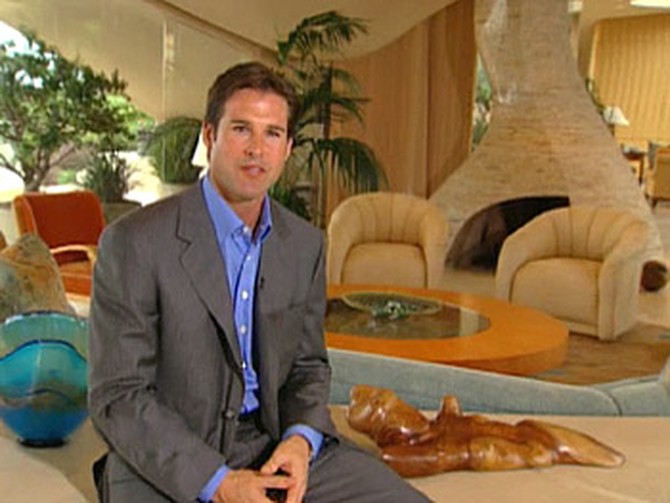
If you shell out $75 million for the Portabello Estate, you'll get 30,000 square feet of space, eight bedrooms, 10 and a half baths and spectacular views of the Pacific Ocean from almost every room, John says.
Potential buyers also don't have to worry about finding couches to fit along the curved walls...all the furniture is included with the house. "The furniture in this house has been meticulously designed and made to fit the size and scale of the house," John says "If you pay your $75 million, you just bring your toothbrush and you move right in."
High-tech gadgets also add to the "wow" factor. In one room, glass walls open up to an outdoor Jacuzzi with the press of a button. In the kitchen, you'll find heated countertops, and in the executive office, you'll find leather floors and custom woodwork.
"This is truly a trophy home...it's a landmark," John says. "I think the beauty of this house is the artisanship that was used to embrace nature, but the best compliment that you can give any property is that when you're here, you don't want to leave."
Potential buyers also don't have to worry about finding couches to fit along the curved walls...all the furniture is included with the house. "The furniture in this house has been meticulously designed and made to fit the size and scale of the house," John says "If you pay your $75 million, you just bring your toothbrush and you move right in."
High-tech gadgets also add to the "wow" factor. In one room, glass walls open up to an outdoor Jacuzzi with the press of a button. In the kitchen, you'll find heated countertops, and in the executive office, you'll find leather floors and custom woodwork.
"This is truly a trophy home...it's a landmark," John says. "I think the beauty of this house is the artisanship that was used to embrace nature, but the best compliment that you can give any property is that when you're here, you don't want to leave."
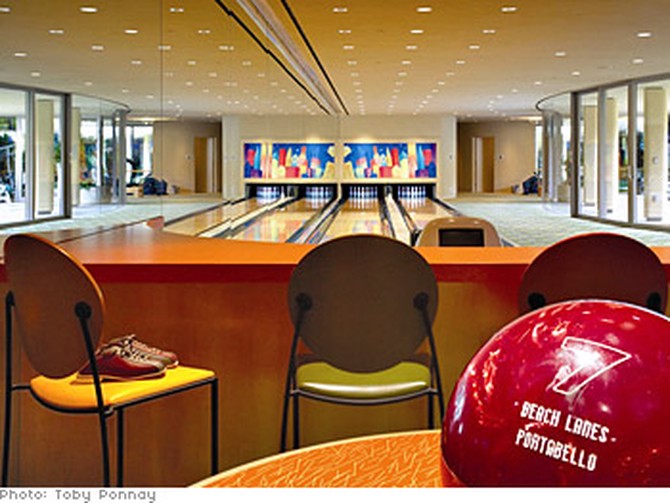
Imagine having the money and the imagination to recreate the street scene from your hometown...that's exactly what Portabello's original owner did! Inside the home, there's a replica of a street from his hometown, Charleston, West Virginia.
Along memory lane, you'll find the bowling alley designed after the alley where the owner played as a child—complete with two regulation lanes, a bar and shoe rental. Nearby, there's an Art Deco movie theater called the Rialto, which has its own concession stand, 12 custom couches and motorized velvet drapes.
From the Rialto, it's a short stroll to the Blossom Dairy Café, a small-scale diner where you can grab a milkshake after the movie. Then, it's on to Kay's Jewelers, the ideal place to display family heirlooms and precious jewelry.
"There are 30,000 square feet of fun!" John says.
Along memory lane, you'll find the bowling alley designed after the alley where the owner played as a child—complete with two regulation lanes, a bar and shoe rental. Nearby, there's an Art Deco movie theater called the Rialto, which has its own concession stand, 12 custom couches and motorized velvet drapes.
From the Rialto, it's a short stroll to the Blossom Dairy Café, a small-scale diner where you can grab a milkshake after the movie. Then, it's on to Kay's Jewelers, the ideal place to display family heirlooms and precious jewelry.
"There are 30,000 square feet of fun!" John says.
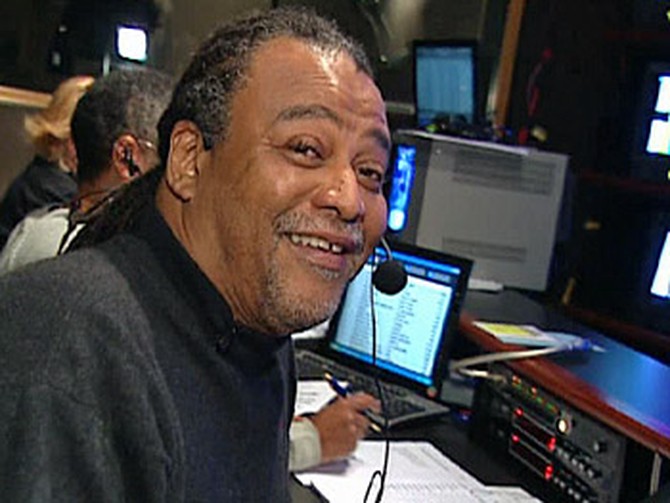
Ever wonder what it takes to get The Oprah Show into your living room? The nerve center of the show is in the control room, where an entire team of Harpo employees control the images and sounds that you see and hear on television.
It all starts with the show's director, Joe. "We have as many as 10 cameras," Joe says. "It gets very hectic in here at times."
Joe coordinates with the show producers, who make decisions that the control room staff needs to react to in a split second. Joe also makes sure that certain camera shots are pulled off, including one that shows 10 different shots in 10 seconds! "I call it a flurry," Joe says. "[It] lets the viewer at home know the excitement that's going on out on the set."
It all starts with the show's director, Joe. "We have as many as 10 cameras," Joe says. "It gets very hectic in here at times."
Joe coordinates with the show producers, who make decisions that the control room staff needs to react to in a split second. Joe also makes sure that certain camera shots are pulled off, including one that shows 10 different shots in 10 seconds! "I call it a flurry," Joe says. "[It] lets the viewer at home know the excitement that's going on out on the set."
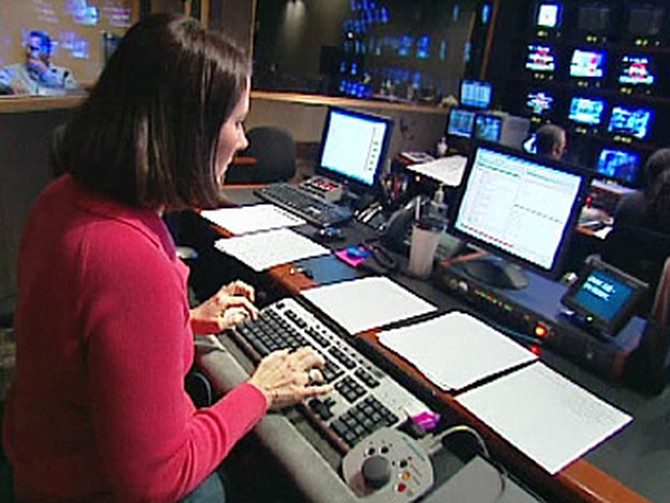
Of course, one man can't run a television show by himself! Sally Jo, the associate director, helps keep the show on schedule. "I tell Oprah when to go to commercial break," Sally Jo says. "On a live show, the timing is critical."
Tara is the production designer and the lighting director. "I'm responsible for the scenery and the lighting and making everybody look good," Tara says. From the control room, Tara controls 65 moving lights and nearly 500 conventional lights. With so many bulbs burning, Harpo's electricity bill is about $65,000 a month, she says.
Sandie runs the teleprompter—the machine that Oprah sometimes reads from. "Sometimes, we're running a little late, we have to go to break, so I'll put up something that's called a tease," Sandie says. "A tease lets you at home know what's coming up in the next segment."
Heather is one of the lawyers here at Harpo. "When we're live, it's a little nerve-wracking," she says. "There's this button, which is on a seven-second delay, and if someone curses or says something they're not supposed to, then I have that short amount of time to decide whether I have to bleep them or not."
"When we're live, that's a great adrenaline rush because you get one chance at it and that's it," Joe says. "With this great team, we pull it off."
Tara is the production designer and the lighting director. "I'm responsible for the scenery and the lighting and making everybody look good," Tara says. From the control room, Tara controls 65 moving lights and nearly 500 conventional lights. With so many bulbs burning, Harpo's electricity bill is about $65,000 a month, she says.
Sandie runs the teleprompter—the machine that Oprah sometimes reads from. "Sometimes, we're running a little late, we have to go to break, so I'll put up something that's called a tease," Sandie says. "A tease lets you at home know what's coming up in the next segment."
Heather is one of the lawyers here at Harpo. "When we're live, it's a little nerve-wracking," she says. "There's this button, which is on a seven-second delay, and if someone curses or says something they're not supposed to, then I have that short amount of time to decide whether I have to bleep them or not."
"When we're live, that's a great adrenaline rush because you get one chance at it and that's it," Joe says. "With this great team, we pull it off."
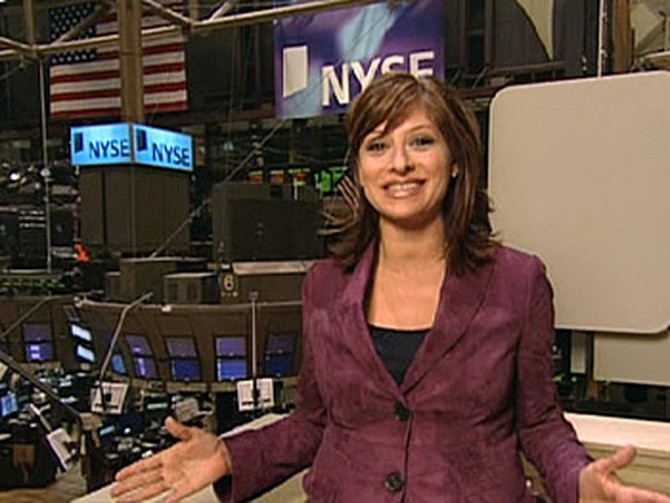
When most people see the New York Stock Exchange on television, it's filled with frantic traders. Not on this tour! Maria Bartiromo, host and managing editor of CNBC's Wall Street Journal Report, is taking you on a special after-hours tour of the trading floor to explain how it all works.
Each day at the New York Stock Exchange, millions of dollars can be made or lost in a matter of minutes. Before you can take on Wall Street, Maria says you need to know the basics. First, what is a stock? "A stock is opportunity for you and me to own part of a company," Maria says.
For example, if a company like American Express wants to expand, they need money to do it, Maria explains. "They will sell a portion of their company to the public in exchange for money, and that gives you and me the opportunity to buy a stake in American Express," she says.
Want to sound like a stock market insider? Here's the lingo you need to know!
Now that you know what a stock is, Maria explains what makes the price of it go up and down. "At the simplest level, it has everything to do with supply and demand," she says. "If there are a lot of people buying the stock, it's going to push [the price] higher. If there are people selling the stock ... the price is going to go down."
Each day at the New York Stock Exchange, millions of dollars can be made or lost in a matter of minutes. Before you can take on Wall Street, Maria says you need to know the basics. First, what is a stock? "A stock is opportunity for you and me to own part of a company," Maria says.
For example, if a company like American Express wants to expand, they need money to do it, Maria explains. "They will sell a portion of their company to the public in exchange for money, and that gives you and me the opportunity to buy a stake in American Express," she says.
Want to sound like a stock market insider? Here's the lingo you need to know!
Now that you know what a stock is, Maria explains what makes the price of it go up and down. "At the simplest level, it has everything to do with supply and demand," she says. "If there are a lot of people buying the stock, it's going to push [the price] higher. If there are people selling the stock ... the price is going to go down."
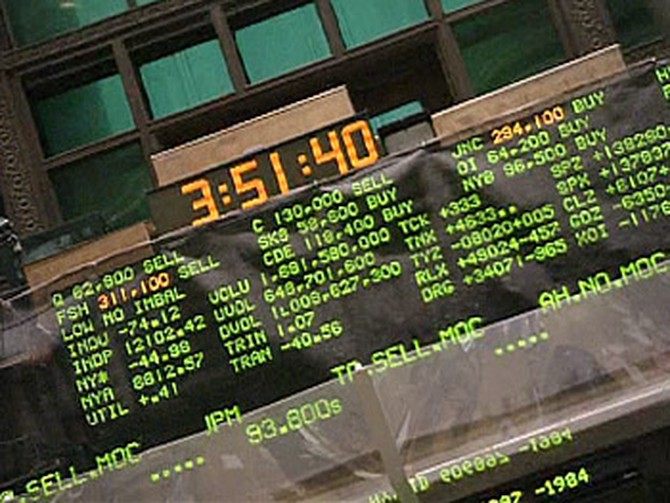
Every day at the New York Stock Exchange, $80 billion changes hands. Who are the people making the big deals? Traders, of course. Maria says 2,500 traders buy and sell stock during market hours, which lasts from 9:30 a.m. to 4 p.m. ET.
Thousands of companies also trade off Wall Street, and all together, they're valued at nearly $24 trillion, Maria says.
On the floor of the stock exchange, there are areas called trading posts, where actual companies are traded.
"If you want to buy something on eBay, you've got to find somebody to sell you that product," Maria says. "It's the same thing that happens in a stock market, only here at the New York Stock Exchange, there's a human being who brings together you the buyer, with someone who is going to sell you that stock."
Thousands of companies also trade off Wall Street, and all together, they're valued at nearly $24 trillion, Maria says.
On the floor of the stock exchange, there are areas called trading posts, where actual companies are traded.
"If you want to buy something on eBay, you've got to find somebody to sell you that product," Maria says. "It's the same thing that happens in a stock market, only here at the New York Stock Exchange, there's a human being who brings together you the buyer, with someone who is going to sell you that stock."
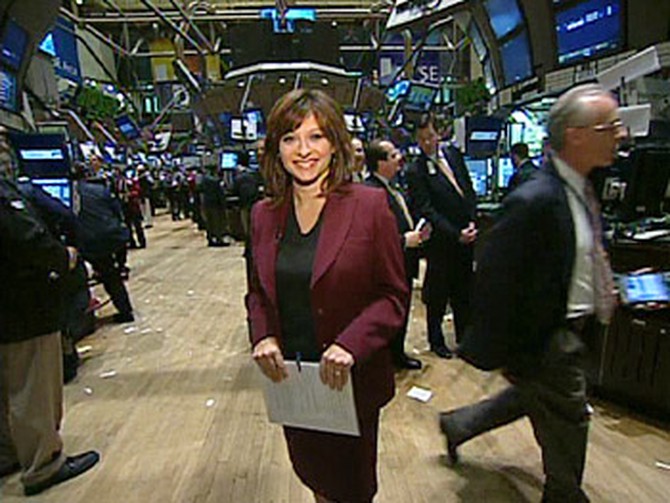
Maria returns to the New York Stock Exchange to get a feel of what it's like when trading is in full swing. On this day, the stock market is at the highest level it's ever been! Just 50 minutes after the opening bell, the Dow Jones industrial average has already gone up 21 points.
"I feel good about the economy," Maria says. "I would not be surprised to see the stock market end at another all-time high."
What advice does Maria have for women who want to start investing? Knowing where the best products are is the first step, Maria says. "We as women, we're the CEOs of our household," Maria says. "We know what we're spending the family disposable income on. Who knows better than you where the good products are?"
Once you identify what companies are producing the best products and turning a profit, it's important to do additional research, Maria says. Then, put your money into the market and hope for the best.
"I feel good about the economy," Maria says. "I would not be surprised to see the stock market end at another all-time high."
What advice does Maria have for women who want to start investing? Knowing where the best products are is the first step, Maria says. "We as women, we're the CEOs of our household," Maria says. "We know what we're spending the family disposable income on. Who knows better than you where the good products are?"
Once you identify what companies are producing the best products and turning a profit, it's important to do additional research, Maria says. Then, put your money into the market and hope for the best.
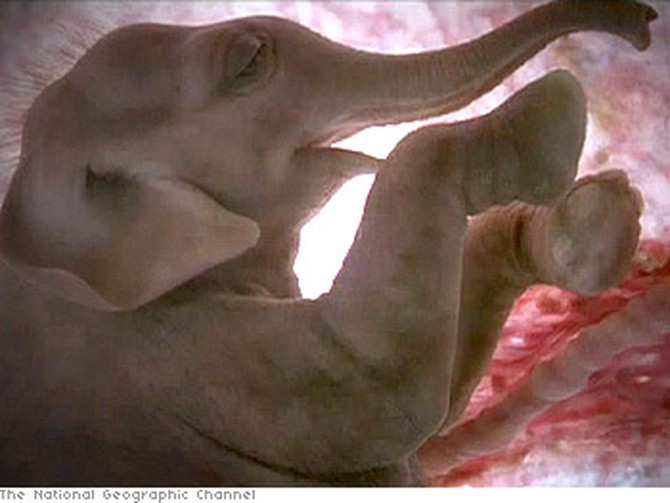
Many people have witnessed the miracle of birth...but very few have seen this miracle from an Asian elephant's point of view. From conception to birth, the National Geographic Channel follows the life cycle from inside the womb of the world's largest land animal.
Compared to pachyderms, humans have it easy. Female elephants carry their babies for almost two years before giving birth to a 250-pound infant! The 22-month pregnancy begins after a male elephant sprays his sperm onto the female and more than five billion sperm make their way inside. The sperm must swim six and a half feet to reach the egg...in humans, sperm only has to travel three inches.
Fourteen weeks after the egg is fertilized, the fetus's heart begins to beat. At this early stage, the elephant is only a half-inch long and weighs less than an ounce. Though the fetus has a long way to go, you can already see a small trunk forming. It may not look like much at first, but eventually, the trunk will be powerful enough to uproot trees.
One year into the pregnancy, the fetus weighs about 25 pounds. The baby elephant can now control its trunk, curling it into its mouth and over its head. Two months later, the sex is revealed and...it's a boy!
With only three months to go, the baby boy is fully developed and weighs 140 pounds. Still, if he is born too early, he will be too small to reach his mother's milk and could starve to death. From this point on, he'll gain a pound a day.
Compared to pachyderms, humans have it easy. Female elephants carry their babies for almost two years before giving birth to a 250-pound infant! The 22-month pregnancy begins after a male elephant sprays his sperm onto the female and more than five billion sperm make their way inside. The sperm must swim six and a half feet to reach the egg...in humans, sperm only has to travel three inches.
Fourteen weeks after the egg is fertilized, the fetus's heart begins to beat. At this early stage, the elephant is only a half-inch long and weighs less than an ounce. Though the fetus has a long way to go, you can already see a small trunk forming. It may not look like much at first, but eventually, the trunk will be powerful enough to uproot trees.
One year into the pregnancy, the fetus weighs about 25 pounds. The baby elephant can now control its trunk, curling it into its mouth and over its head. Two months later, the sex is revealed and...it's a boy!
With only three months to go, the baby boy is fully developed and weighs 140 pounds. Still, if he is born too early, he will be too small to reach his mother's milk and could starve to death. From this point on, he'll gain a pound a day.
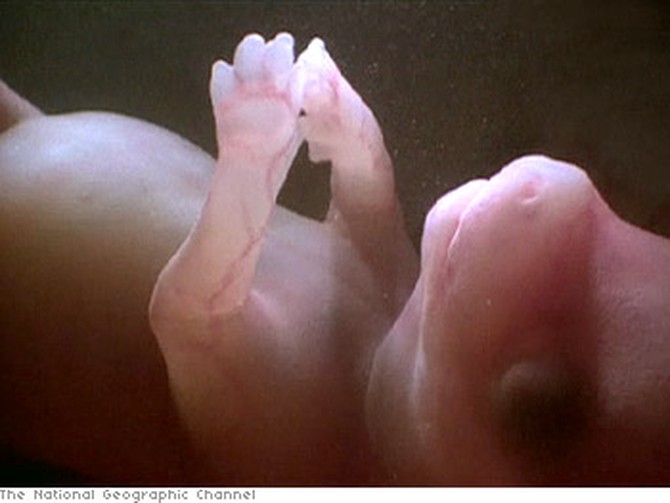
While elephants normally carry just one baby at a time, dogs carry an average of 10 puppies, which explains why there are more than 100 million pups in the world! From the day of conception, it takes just 63 days for a puppy to be born.
From inside the womb, you can see that the embryos of a golden retriever are about the size of a pea when they're 20 days old. By day 30, the embryos are the size of a grape and the puppies have beating hearts. As the puppies develop, their intestines grow outside the body because there's not enough room inside. As the puppies get bigger, the intestines slowly move into their abdomens.
With less than a month to go, the fetuses are about the size of a golf ball. The puppies must constantly move in utero to keep their joints from freezing. With only a week to go, the puppies have grown a full coat of fur.
After 63 days, the tiny golden retrievers are born blind and unable to walk. Moments after the birth, the mother instinctively tears open the birth sac so her babies can breathe. Then, she eats the placenta to ingest chemicals that stimulate milk flow.
To survive, the puppies use their noses to find their mother's nipples. They will bark for the first time about 18 days later, and at just six months old, these little pups can start having puppies of their own!
From inside the womb, you can see that the embryos of a golden retriever are about the size of a pea when they're 20 days old. By day 30, the embryos are the size of a grape and the puppies have beating hearts. As the puppies develop, their intestines grow outside the body because there's not enough room inside. As the puppies get bigger, the intestines slowly move into their abdomens.
With less than a month to go, the fetuses are about the size of a golf ball. The puppies must constantly move in utero to keep their joints from freezing. With only a week to go, the puppies have grown a full coat of fur.
After 63 days, the tiny golden retrievers are born blind and unable to walk. Moments after the birth, the mother instinctively tears open the birth sac so her babies can breathe. Then, she eats the placenta to ingest chemicals that stimulate milk flow.
To survive, the puppies use their noses to find their mother's nipples. They will bark for the first time about 18 days later, and at just six months old, these little pups can start having puppies of their own!
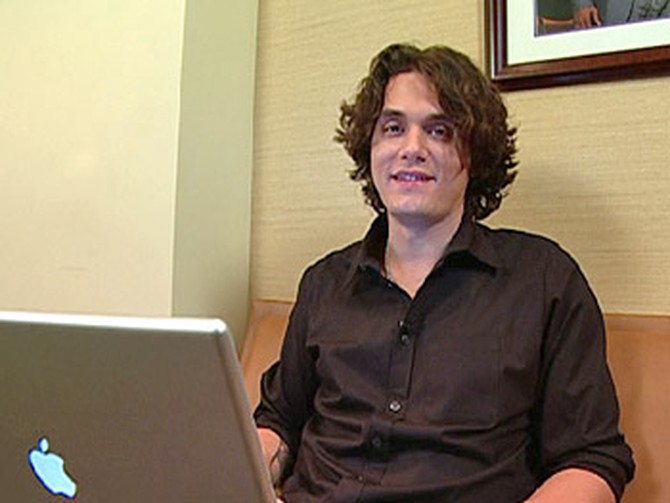
Another place people rarely see is the Harpo greenroom, where Oprah's guests sit and await their moment on stage. Today, three-time Grammy award winner John Mayer gives us a sneak peek inside this exclusive locale.
What's John doing to prepare for his performance? Blogging, of course!
Fresh off the last stop of his world tour, John traveled all the way from Japan to visit The Oprah Show. This singer/songwriter has sold more than 8 million albums and topped the charts with hit songs like "Your Body is a Wonderland" and "Daughters." His CD, Continuum, went platinum in November 2006.
Growing up, John says he "had the blessing and the curse of knowing what I wanted to do when I was 13." An "invisible kid" in school, he couldn't wait to get home and play along to his musical heroes—Sam Cooke, Otis Redding, BB King, Jimi Hendrix and Stevie Ray Vaughan.
John says he even asked his parents—a principal and a teacher—if he could drop out of school to pursue music. He says now he's thankful they didn't let him. "You have to be careful as a successful person because success validates any of the stupid decisions you made in your life," John says.
What's John doing to prepare for his performance? Blogging, of course!
Fresh off the last stop of his world tour, John traveled all the way from Japan to visit The Oprah Show. This singer/songwriter has sold more than 8 million albums and topped the charts with hit songs like "Your Body is a Wonderland" and "Daughters." His CD, Continuum, went platinum in November 2006.
Growing up, John says he "had the blessing and the curse of knowing what I wanted to do when I was 13." An "invisible kid" in school, he couldn't wait to get home and play along to his musical heroes—Sam Cooke, Otis Redding, BB King, Jimi Hendrix and Stevie Ray Vaughan.
John says he even asked his parents—a principal and a teacher—if he could drop out of school to pursue music. He says now he's thankful they didn't let him. "You have to be careful as a successful person because success validates any of the stupid decisions you made in your life," John says.
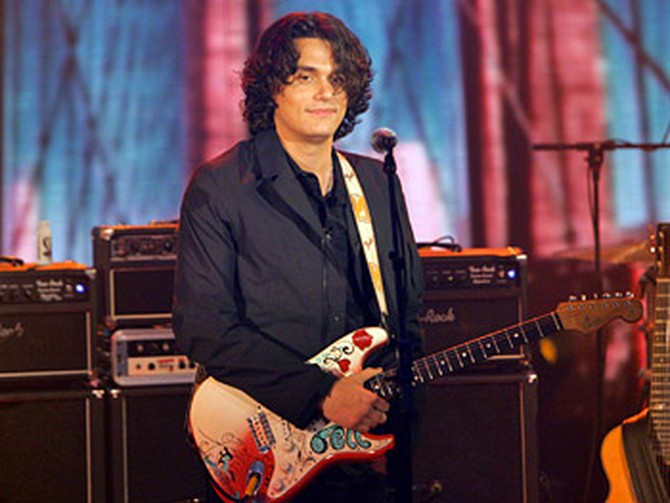
John takes the stage to perform "Waiting on the World to Change," the first single off his album Continuum.
John says he wrote "Waiting on the World to Change" in one night. The song reflects some of the current political climate where one person seems to be "driving the wheel," he says. "I have all this kind of internal energy in wanting to make things happen, but instead I'm sitting on my hands and I'm watching TV and I know what's right and what's wrong," he says.
John says he wrote "Waiting on the World to Change" in one night. The song reflects some of the current political climate where one person seems to be "driving the wheel," he says. "I have all this kind of internal energy in wanting to make things happen, but instead I'm sitting on my hands and I'm watching TV and I know what's right and what's wrong," he says.
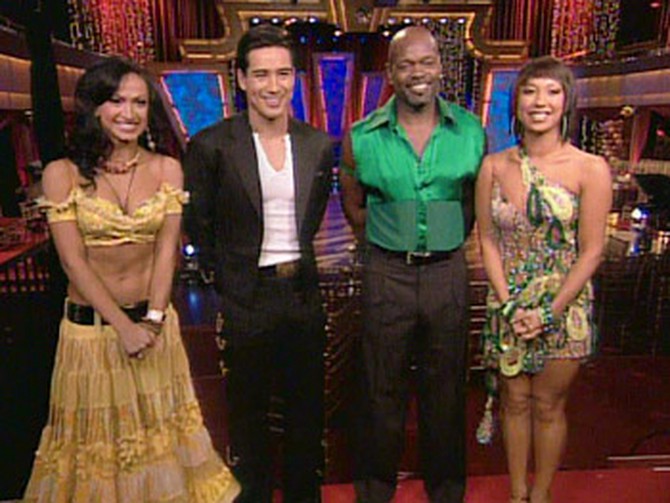
It's the show that has swept America off its feet—even Oprah's security guard watches! Each week millions vote to decide which celebrity will be crowned the winner of ABC's smash hit Dancing with the Stars.
Three-time Super Bowl champ Emmitt Smith, one of the two finalists, had all the right moves on the football field, but on the dance floor he was just a rookie. Emmitt and his partner Cheryl Burke practiced up to 12 hours a day to perfect their routines and make it all the way to the finals. "It's just been a tremendous ride and a tremendous experience," Emmitt says.
Cheryl says Emmitt surprised her from day one. After the first performance, she says she knew that Emmitt had a chance to make it into the finals. "A football player, who would know this guy could just move?" Cheryl says.
Heartthrob actor and television host Mario Lopez is the other celebrity finalist. He and dance partner Karina Smirnoff have heated up the dance floor with their sexy dance moves and red-hot chemistry, but Mario puts the rumors that they are dating to rest. "I should be so lucky, but she's just a strict partner/teacher," Mario says.
After months of practicing and performing, the final results were revealed on November 15, 2006. The winner of the second season of Dancing with the Stars was...Emmitt Smith!
Three-time Super Bowl champ Emmitt Smith, one of the two finalists, had all the right moves on the football field, but on the dance floor he was just a rookie. Emmitt and his partner Cheryl Burke practiced up to 12 hours a day to perfect their routines and make it all the way to the finals. "It's just been a tremendous ride and a tremendous experience," Emmitt says.
Cheryl says Emmitt surprised her from day one. After the first performance, she says she knew that Emmitt had a chance to make it into the finals. "A football player, who would know this guy could just move?" Cheryl says.
Heartthrob actor and television host Mario Lopez is the other celebrity finalist. He and dance partner Karina Smirnoff have heated up the dance floor with their sexy dance moves and red-hot chemistry, but Mario puts the rumors that they are dating to rest. "I should be so lucky, but she's just a strict partner/teacher," Mario says.
After months of practicing and performing, the final results were revealed on November 15, 2006. The winner of the second season of Dancing with the Stars was...Emmitt Smith!
Published 11/15/2006

